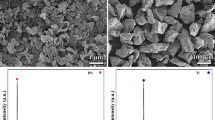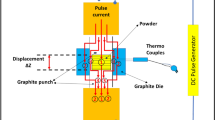Abstract
Graphite nanomaterials offer desired mechanical, geometric, and stability attributes for use as a discrete reinforcement system capable of enhancing the mechanical and durability performance of cement-based materials. This work employed nuclear magnetic resonance (NMR) spectroscopy techniques in order to gain further insight into the effects of distinctly high specific surface area and close spacing of graphite nanoplatelets with planar morphology on the structure of cement hydrates. 29Si and 27Al NMR spectroscopy techniques were employed, and analysis of results emphasized identification of the bonding conditions of SiO4 tetrahedra for resolving the structure of calcium silicate hydrate (C–S–H). Plain hydrated cement paste as well as those reinforced with graphite nanoplatelets was evaluated via NMR spectroscopy at 3 and 14 days of age. Addition of graphite nanoplatelets was found to increase the Q1/Q2 ratio, pointing to a reduction in the degree of polymerization of silicate tetrahedral in the C–S–H structure. The presence of graphite nanoplatelets also lowered the polarization of Q3, indicating reduced branching sites of C–S–H. Analysis of 27Al NMR spectra indicated that addition of graphite nanoplatelets lowered the concentration of calcium aluminate monosulfate hydrate among cement hydration products.









Similar content being viewed by others
References
Balázsi C, Wéber F, Kövér Z, Shen Z, Kónya Z, Kasztovszky Z et al (2006) Application of carbon nanotubes to silicon nitride matrix. Curr Appl Phys 6(2):124–130
Blumich B, Anferova S, Casanova F, Kremer K, Perlo J, Sharma S (2004) NMR: principles and application to quality control of elastomer products. KGK-Kautschuk und Gummi Kunststoffe 57(7–8):346–349
Blumich B, Haber A, Casanova F, Del Federico E, Boardman V, Wahl G et al (2010) Noninvasive depth profiling of walls by portable nuclear magnetic resonance. Raman spectroscopy (pp 2629–2760)/mass spectrometry (pp 2761–2916), 7 edn. Springer, Heidelberg, pp 3117–3125
Brunet F, Charpentier T, Chao CN, Peycelon H, Nonat A (2010) Characterization by solid-state NMR and selective dissolution techniques of anhydrous and hydrated CEM V cement pastes. Cem Concr Res 40(2):208–219
Cahn RW (2002) Pergamon materials series. Elsevier, Amsterdam
Cwirzen A, Habermehl-Cwirzen K, Penttala V (2008) Surface decoration of carbon nanotubes and mechanical properties of cement/carbon nanotube composites. Adv Cem Res 20(20):65–73
Friedemann K, Stallmach F, Karger J (2006) NMR diffusion and relaxation studies during cement hydration—a non-destructive approach for clarification of the mechanism of internal post curing of cementitious materials. Cem Concr Res 36(5):817–826
Hu J, Koleva DA, Ma Y, Eshlangen E, Petrov P, Breugel KV (2012) The influence of admixed micelles on the microstructural properties and global performance of cement-based materials. Cem Concr Res 42:1122–1133
Kuzumaki T, Ujiie O, Ichinose H, Ito K (2000) Mechanical characteristics and preparation of carbon nanotube fiber-reinforced Ti composite. Adv Eng Mater 2(7):416–418
Land G, Stephan D (2012) The influence of nano-silica on the hydration of ordinary Portland cement. J Mater Sci 47(2):1011–1017
Li GY, Wang PM, Zhao X (2005) Mechanical behavior and microstructure of cement composites incorporating surface-treated multi-walled carbon nanotubes. Carbon 43(6):1239–1245
Li GY, Wang PM, Zhao X (2007) Pressure-sensitive properties and microstructure of carbon nanotube reinforced cement composites. Cem Concr Compos 29(5):377–382
MacKenzie KJD, Smith ME (2002) Multinuclear solid-state nuclear magnetic resonance of inorganic materials. Pergamon Press, Oxford
Makar JM, Chan W (2008) End of the induction period in ordinary portland cement as examined by high-resolution scanning electron microscopy. J Am Ceram Soc 91:1292–1299
Makar JM, Chan GW (2009) Growth of cement hydration products on single-walled carbon nanotubes. J Am Ceram Soc 92(6):1303–1310
Matalkah F, Soroushian P, Abideen SU, Peyvandi A (2016a) Use of non-wood biomass combustion ash in development of alkali-activated concrete. Constr Build Mater 121:491–500
Matalkah F, Soroushian P, Balchandra A, Peyvandi A (2016b) Characterization of alkali-activated nonwood biomass ash-based geopolymer concrete. J Mater Civ Eng 29(4):04016270
Matalkah F, Soroushian P, Weerasiri RR, Peyvandi A (2017) Development of indigenous binders as construction materials. In: Proceedings of the institution of civil engineers-construction materials, pp 1–10
Mehta PK, Monteiro JM (2005) Concrete: microstructure, properties, and materials. McGraw-Hill Companies, Inc., New York
Moradian M, Shekarchi M, Pargar F, Bonakdar A, Valipour M (2012) Deterioration of concrete caused by complex attack in sewage treatment plant environment. J Perform Constr Facil 26(1):124–134
Peyvandi A, Soroushian P, Jahangirnejad S (2013a) Enhancement of the structural efficiency and performance of concrete pipes through fiber reinforcement. Constr Build Mater 45:36–44
Peyvandi A, Ahmed Sbia L, Soroushian P, Sobolev K (2013b) Effect of the cementitious paste density on the performance efficiency of carbon nanofiber in concrete nanocomposite. Constr Build Mater 48:265–269
Peyvandi A, Soroushian P, Abdol N, Balachandra A (2013c) Surface-modified graphite nannomaterials for improved reinforcement efficiency in cementitious paste. Carbon 63:175–186
Peyvandi A, Holmes D, Soroushian P, Balachandra AM (2014a) Monitoring of sulfate attack in concrete by Al 27 and Si 29 MAS NMR spectroscopy. J Mater Civ Eng 27(8):04014226
Peyvandi A, Holmes D, Balachandra AM, Soroushian P (2014b) Quantitative analysis of chloride ion diffusion in cementitious materials using Al 27 NMR spectroscopy. J Infrastruct Syst 21(3):04014047
Porteneuve C, Zanni H, Vernet C, Kjellsen KO, Korb J-P, Petit D (2001) Nuclear magnetic resonance characterization of high- and ultrahigh-performance concrete: application to the study of water leaching. Cem Concr Res 31(12):1887–1893
Richardson IG (2000a) The nature of the hydration products in hardened cement pastes. Cem Concr Compos 22:97–113
Richardson I (2000b) The nature of the hydration products in hardened cement pastes. Cem Concr Compos 22(2):97–113
Sanchez F, Sobolev K (2010) Nanotechnology in concrete—a review. Constr Build Mater 24:2060–2071
Sbia LA, Peyvandi A, Soroushian P, Balachandra AM (2014) Optimization of ultra-high-performance concrete with nano-and micro-scale reinforcement. Cogent Eng 1(1):990673
Skibsted J, Hall C (2008) Characterization of cement minerals, cements and their reaction products at the atomic and nano scale. Cem Concr Res 38(2):205–225
Taylor HFW (1997) Cement chemistry. Thomas Telford, London
Tyson BM, Abu Al-Rub RK, Yazdanbakhsh A, Grasley Z (2011) Carbon nanotubes and carbon nanofibers for enhancing the mechanical properties of nanocomposite cementitious materials. ASCE J Mater Civ Eng 23(7):1–8
Wei T, Fan Z, Luo G, Wei F (2008) A new structure for multi-walled carbon nanotubes reinforced alumina nanocomposite with high strength and toughness. Mater Lett 62:641–644
Xia Z, Riester L, Curtin WA, Li H, Sheldon BW, Liang J et al (2004) Direct observation of toughening mechanisms in carbon nanotube ceramic matrix composites. Acta Mater 52:931–944
Xiang X, Torwald TL, Staedler T, Trettin RHF (2005) Carbon nanotubes as a new reinforcement material for modern cement-based binders. In: NICOM 2: 2nd international symposium on nanotechnology in construction. RILEM Publications SARL
Xie XL, Mai YW, Zhou XP (2005) Dispersion and alignment of carbon nanotubes in polymer matrix: a review. Mater Sci Eng 49:89–112
Yazdanbakhsh A, Grasley Z, Tyson B, Al-Rub RK (2010) Distribution of carbon nanofibers and nanotubes in cementitious composites. J Transp Res Board 2142:89–95
Acknowledgements
The authors wish to acknowledge the financial support of the Department of Transportation (DOT) Contract No. DTRT57-12-C-10064 for the study report herein. The authors are thankful to Fred Faridazar from U.S. DOT (Turner-Fairbank Highway Research Center) for his guidance and support throughout the project. The authors are also thankful to Dr. Rui H. Huang for running NMR spectroscopy on the prepared samples.
Author information
Authors and Affiliations
Corresponding author
Rights and permissions
About this article
Cite this article
Farhadi, N., Peyvandi, A., Holmes, D. et al. Effects of Graphite Nanoplatelets on the Structure of Cementitious Materials. Iran J Sci Technol Trans Civ Eng 43 (Suppl 1), 403–411 (2019). https://doi.org/10.1007/s40996-018-0173-5
Received:
Accepted:
Published:
Issue Date:
DOI: https://doi.org/10.1007/s40996-018-0173-5




